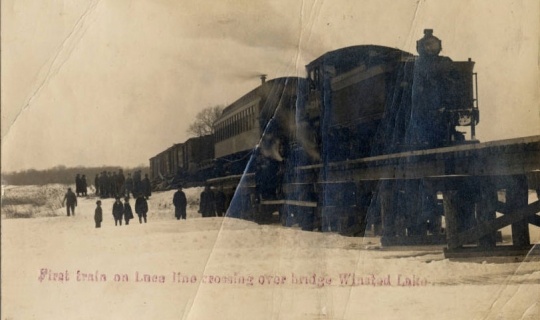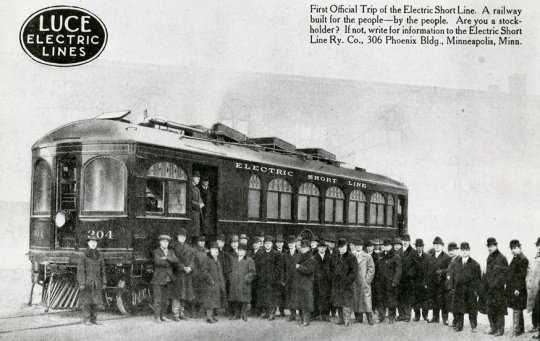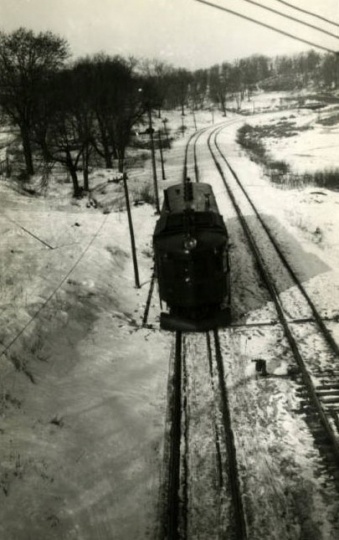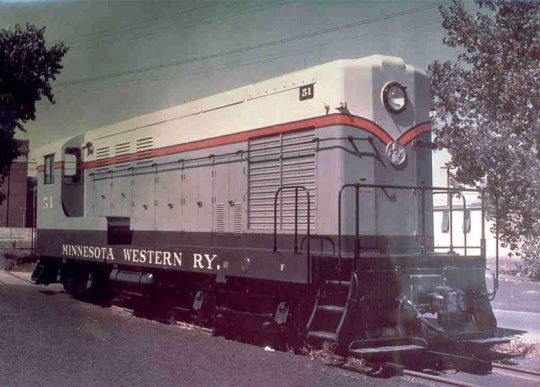The Luce Line Railroad, known by several different names, was a small rural Minnesota railroad that operated through much of the twentieth century. It connected rural communities in western Minnesota to the Twin Cities and offered transportation for passengers, lumber, grain, and other commodities.
On August 7, 1908, Colonel William L. Luce and his son, Erle D. Luce, incorporated the Electric Short Line Railroad. Although late by most standards, the Luce family intended to build a railroad that would connect rural Minnesota communities that were still without rail service by creating a line to Brookings, South Dakota. Construction began in 1909 and continued slowly over the next four years.
At this stage, the portion of the line east of Glenwood Junction in Minneapolis was the Electric Short Line Terminal Company, with new construction to the west called the Electric Short Line Railway. The distinction did not last long; nor did “electric” have any meaning, as the line could never afford overhead electrification.
In 1913, rail was laid westward between Minneapolis and Parkers Lake. Construction continued from Glenwood Junction in Minneapolis to Stubbs Bay on Lake Minnetonka, then further west to the communities of Watertown, Winsted, and Silver Lake until reaching Hutchinson in 1915. By this time, the line offered passenger service through a small fleet of motorcars that ran in both directions along the line. It also ran freight trains using second-hand steam locomotives from larger railroads. By 1917, there were nearly seventy-one miles of track on the line, including areas that were double tracked.
The Luce Line was built relatively late in comparison to other lines and serviced already-established cities. For this reason, it did not create new rural communities. The line would often build around the outskirts of existing towns instead. The line reached both Cosmos and Lake Lillian in 1923.
The Luce family encountered financial difficulty in the form of foreclosure and reorganized the line as the Minnesota Western on May 1, 1924. Construction continued to Gluek in 1927, but by December of that year, the Luce family sold their interests to the Minneapolis, Northfield and Southern Railway. Although the line now extended 115 miles between Minneapolis and Gluek, additional construction ceased because continued funding was not available. The line did not reach Brookings, South Dakota, and never went any further west. Gluek was to be the permanent western terminus of the “Luce Line” or Electric Short Line, known by this time as the Minnesota Western.
The line offered several passenger trains between both ends of the route and hauled freight in each direction, servicing a number of rural industries along the right of way.
Not surprisingly, as rural roadways improved, the need for passenger service diminished. The communities served by the Luce Line provided few passengers. By 1942, passenger trains typically required only one railcar. The road thus became freight only as of September 10, 1947, when the last passenger train ran. Steam locomotives were phased out, and only diesel engines hauled freight.
In 1956, the much larger Minneapolis and St. Louis Railway (the M&STL), a Midwestern agricultural carrier, purchased the Minnesota Western from the Cargill company. In early 1960, the M&STL renamed the Minnesota Western railroad the Minneapolis Industrial Railway. The Chicago and Northwestern (C&NW) purchased the Minneapolis and St. Louis itself later that year on November 1, 1960.
The C&NW was a much larger company and therefore had little use for the small Luce Line. The company petitioned to abandon the segment of the railroad from Hutchinson to Gluek in 1967. The C&NW physically removed the line shortly after approval was granted. In the next year, the C&NW asked to abandon the railroad from Hutchinson to Plymouth. The state of Minnesota subsequently granted approval.
By 1972, the line extended from Minneapolis to Plymouth, with the remaining 104 miles of the line to Gluek now abandoned and removed as scrap. The line to Plymouth eventually became part of the Union Pacific railroad, in April 1995. Most of the remaining right of way west of Plymouth became a public recreational trail for bicycling, snowmobiling, and horseback riding.











